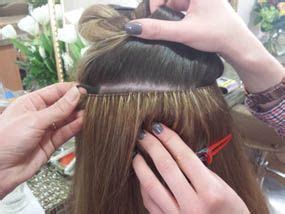Hair extensions have revolutionized the beauty industry, empowering individuals to transform their hair’s length, volume, and color with unmatched ease. With a plethora of options available, it can be overwhelming to navigate the world of hair extensions. This comprehensive guide delves into the various types of extensions, their unique characteristics, and the factors that determine the best choice for your individual needs.

Types of Hair Extensions: A Comprehensive Overview
Human Hair Extensions
Renowned for their luxurious feel and natural appearance, human hair extensions mimic the quality of your own hair. They offer unparalleled versatility, allowing for styling, coloring, and heat treatments, just as you would your natural hair. However, human hair extensions come at a higher price point compared to synthetic options.
Synthetic Hair Extensions
Synthetic hair extensions are crafted from synthetic fibers, offering a more budget-friendly alternative. They excel in providing vibrant colors, unconventional styles, and enhanced durability. However, they may lack the natural movement and texture of human hair extensions.
Extension Application Methods: Understanding the Techniques
Clip-In Extensions
Clip-in extensions are the most user-friendly option, allowing you to attach and remove them with ease. They come in a range of colors and lengths, providing instant transformation without the need for commitment or professional installation.
Tape-In Extensions
Tape-in extensions are applied by sandwiching sections of your natural hair between thin tape wefts. They offer a discreet and long-lasting solution, blending seamlessly with your natural hair. However, their removal requires professional assistance to avoid damage.
Sew-In Extensions
Sew-in extensions, also known as weft extensions, are sewn onto cornrows or braids created along the scalp. They provide a secure and volumizing effect, offering significant length and fullness. However, sew-in extensions require professional installation and may cause tension on your natural hair.
Fusion Extensions
Fusion extensions are attached to your natural hair using heat-activated glue or keratin bonds. They offer a sturdy hold, lasting several months. However, the removal process requires heat and can be damaging to your natural hair if not done properly.
Bonded Extensions
Bonded extensions are similar to fusion extensions, but instead of glue or keratin, they are attached using a cold fusion technique. This method is less damaging to natural hair but may result in a shorter lifespan than fusion extensions.
Choosing the Right Extensions: A Guided Approach
Selecting the appropriate hair extensions depends on your desired outcome, lifestyle, and budget. Consider the following factors:
Lifestyle
If you desire versatility and frequent hair transformations, clip-in or tape-in extensions may be ideal. For long-term solutions that blend seamlessly, sew-in or fusion extensions could be more suitable.
Budget
Human hair extensions command a higher price than synthetic options. Synthetic extensions offer budget-friendly alternatives, but their longevity may be compromised.
Hair Type and Condition
Consider your natural hair texture, thickness, and current condition. Extensions that mimic the feel and texture of your natural hair will provide a more seamless blend.
Table 1: Overview of Hair Extension Methods
| Method | Attachment | Removal | Lifespan | Damage Potential |
|---|---|---|---|---|
| Clip-In | Clips | DIY | Instant | Low |
| Tape-In | Adhesive tapes | Professional | 6-8 weeks | Moderate |
| Sew-In | Braiding | Professional | 2-3 months | High |
| Fusion | Heat-activated glue/Keratin | Professional | 3-6 months | Moderate-High |
| Bonded | Cold fusion bonding | Professional | 2-3 months | Low-Moderate |
Table 2: Comparing Human and Synthetic Hair Extensions
| Feature | Human Hair | Synthetic Hair |
|---|---|---|
| Appearance | Natural | Artificial |
| Feel | Soft and silky | Rough and plastic-like |
| Styling | Versatile; can be dyed, styled with heat | Limited styling options; heat-sensitive |
| Durability | Long-lasting | Shorter lifespan |
| Cost | Higher | Lower |
Table 3: Pros and Cons of Different Extension Methods
| Method | Pros | Cons |
|---|---|---|
| Clip-In | Convenient application and removal; low cost | Limited lifespan; noticeable attachments |
| Tape-In | Seamless blend; long lifespan | Professional removal required; can cause scalp irritation |
| Sew-In | Voluminous and natural-looking; long lifespan | Requires professional installation and removal; can cause tension on natural hair |
| Fusion | Secure hold; long lifespan | Heat damage during removal; expensive |
| Bonded | Less damaging than fusion; secure hold | Shorter lifespan than fusion; removal can be difficult |
Questions to Ask Before Investing in Hair Extensions
- What is my desired length, volume, and color transformation?
- How often do I plan on wearing and styling the extensions?
- What is my budget for hair extensions and maintenance?
- What is my natural hair texture, thickness, and condition?
- Am I comfortable with professional installation and removal?
Conclusion
The world of hair extensions offers a transformative solution to enhance your locks and express your personal style. By understanding the different types, application methods, and factors influencing your choice, you can make an informed decision that aligns with your hair goals and lifestyle. Remember to consult a professional hairstylist for personalized advice and ensure the safe and seamless integration of hair extensions.
